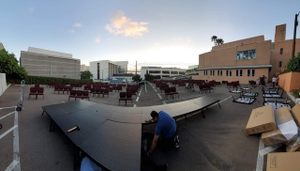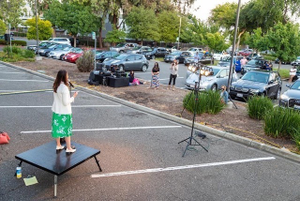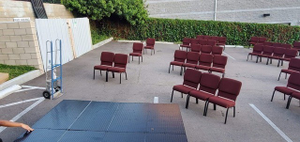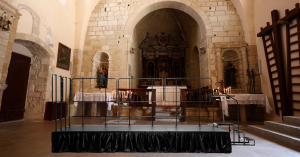Introduction
Choosing the right stage for your event—whether a portable stage or a permanent structure—is crucial for success. This decision impacts the performance quality and the audience's overall experience. This guide will explore the key differences between a portable stage vs. a permanent stage and the benefits of portable stages, helping you understand which option best suits your event's needs. From flexibility and cost to customization and venue requirements, get ready to discover how to enhance your next event with the perfect stage for your outdoor event.
What are Portable Stages?
Portable stages are dynamic, modular platforms designed for temporary events and performances. They consist of lightweight, interlocking sections that can be easily assembled and disassembled, offering unmatched flexibility for various venues and occasions. These modular stages typically feature adjustable heights and are constructed from durable materials like aluminum or reinforced plastic, ensuring stability while remaining transportable. Key features include quick setup mechanisms, such as foldable drum risers, camera risers, stage railings, and snap-lock systems, making them ideal for touring groups, outdoor festivals, and community events. Their versatility also extends to customization, as they can be configured in multiple shapes and sizes to fit specific event needs.
What are Permanent Stages?
Permanent stages are built-in structures designed to serve as enduring fixtures in venues such as theaters, concert halls, and schools. These stages are constructed from robust materials like wood and steel, ensuring long-term durability and supporting substantial weight loads. Unlike their portable counterparts, permanent stages are not meant to be moved or reconfigured, providing a stable and reliable platform for a wide range of performances and events. Key characteristics include built-in lighting rigs, sound systems, and often sophisticated machinery for stage effects, all integrated into the architecture of the venue itself. This integration allows for more complex productions and can significantly enhance the overall production quality of events hosted in such spaces.
Differences Between Portable Stages and Permanent Stages
Event planners and venue managers must grasp the differences between portable and permanent stages. Both types serve as platforms for performances and presentations, but each has unique features suited to specific needs and situations. Exploring these disparities reveals critical factors to weigh when selecting the ideal stage for an event.
Durability and Stability
Permanent stages are built for durability and stability, using materials to last and withstand rigorous use. They are integrated into the venue's structure, offering robust support for heavy equipment and elaborate setups. In contrast, portable stages provide practical durability suited for temporary setups. While they are designed to be sturdy and safe, they do not match the permanence and immovability of built-in stages. Portable stages need regular checks and maintenance to ensure stability, especially when repeatedly assembled and disassembled for various events.
Flexibility
Portable stages excel in flexibility, allowing for quick adaptation to different venues and event types. They can be assembled in various configurations and are easy to transport, making them ideal for events that require quick setup and teardown. On the other hand, permanent stages are fixed in design and location, offering limited flexibility but ensuring a consistent performance environment. This makes them well-suited for venues that regularly host similar events or productions.
Venue Requirements and Restrictions

Choosing between a portable or permanent stage often depends on the venue's requirements and restrictions. Portable stages are beneficial in multi-purpose spaces where the stage area needs to be cleared for other activities or in locations where a permanent stage would be impractical due to space or structural limitations. Permanent stages are more common in dedicated performance spaces where architectural and aesthetic considerations align with a fixed stage setup, providing an optimal layout for acoustics and visibility without frequent changes.
Suitability for Different Events
Portable stages offer unparalleled versatility, making them suitable for various events, from outdoor festivals to indoor conferences. Their ability to adapt to different settings and event styles is a significant advantage for event planners who need quick solutions in varied locations. Permanent stages, however, are ideal for venues that host similar events repeatedly, such as theaters and concert halls, where the need for a consistent, specialized performance space outweighs the need for versatility.
Customization Options
Customization is a key advantage of portable stages, which can be modified to fit different themes and physical layouts. Modular components allow for various configurations, accommodating unique event needs and audience sizes. Permanent stages, while less flexible in terms of layout changes, offer extensive customization in terms of technical setups, such as lighting, sound, and special effects, which can be permanently integrated into the structure, enhancing the overall production quality of performances hosted there.
Cost Considerations
Cost considerations between portable and permanent stages vary significantly. Portable stages are generally less expensive upfront, offering cost-effective solutions for organizations that require staging for multiple locations or infrequent events. The ability to dismantle and transport these stages also reduces long-term costs associated with dedicated venues. In contrast, permanent stages require a higher initial investment but provide value over time for venues that regularly host events, as they do not require setup and breakdown costs and are designed for durability and long-term use.
Conclusion
Choosing between portable and permanent stages hinges on your specific event needs and venue requirements. Portable stages provide flexibility and ease of use for varying locations and event types, making them ideal for those who value versatility. Permanent stages, however, are best for dedicated spaces that host regular performances, offering stability and integrated technical capabilities. Assess your event's frequency, location, and technical demands to determine which stage option will best support your goals, ensuring success and safety for every performance.






